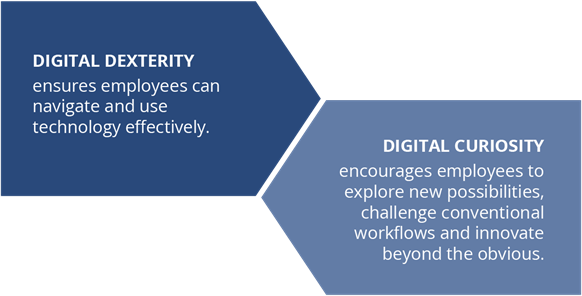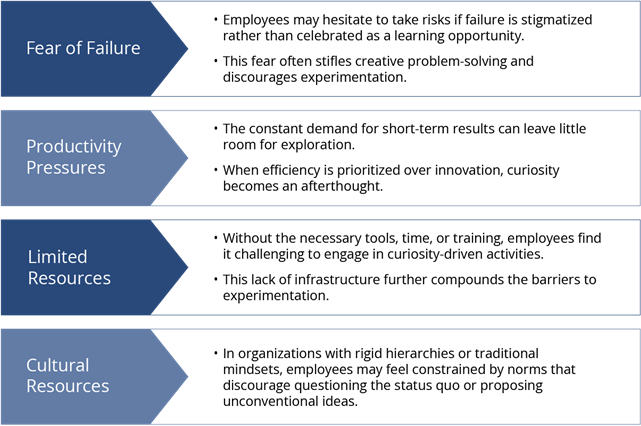Today’s workplace is characterized by technology-driven change at hyper speed, evolving business models and shifting employee expectations. This makes it mandatory to adapt and innovate. At the heart of this transformation is a fundamental, innate human trait that is often underestimated: curiosity.
Curiosity is more than just a personality trait; it is a strategic enabler for navigating uncertainty and embracing the opportunities of the AI era. Organizations that cultivate curiosity unlock their employees’ potential to question assumptions and explore new possibilities. In doing so, they position themselves as leaders in an increasingly competitive landscape.
But how do organizations build a workplace that fosters curiosity in meaningful, measurable ways?
Let's revive curiosity as a new personal superpower in the age of AI.
Why Curiosity Matters in the Modern Workplace
The advent of AI and other transformative technologies has amplified the importance of curiosity. These tools promise to revolutionize how we work, offering efficiency gains and new opportunities for innovation. Yet their successful integration requires more than technical know-how; it demands a workforce willing to experiment, adapt and embrace continuous learning.

Figure 1: The Ecosystem of Curiosity: Building Blocks for Modern Workplaces (source, ISG)
Figure 1 shows the benefits that come from a culture of curiosity. It can function as an antidote to challenges many enterprises face, including resistance to change, fear of failure and a lack of engagement with new technologies. Curiosity can help employees and leaders alike to view change as an opportunity rather than a threat.
AI’s transformative power depends not on its technical capabilities but on how people interact with it. Encouraging curiosity allows employees to move beyond initial skepticism and explore AI’s possibilities, leading to innovative use cases tailored to organizational goals.
The Mindset for Finding the Golden AI Use Case
The hunt to do more with less is not over. And AI needs to be part of the solution. Not everyone realizes that finding AI’s “golden use case” often begins with open-minded experimentation. Intrinsically motivated employees are more likely to identify these breakthrough applications, which often lie outside predefined workflows. For instance, an AI tool originally introduced for process automation might unexpectedly enhance cross-departmental collaboration or creative ideation. This kind of workplace serendipity is a product of a culture of curiosity and opportunity.
AI’s low learning curve makes it a perfect tool for curious minds. Regular exploration and iterative learning create opportunities to discover hidden capabilities and drive meaningful improvements in productivity and innovation.
Moreover, curiosity is increasingly seen as a critical leadership trait, enabling leaders to inspire teams, navigate complexity and foster a culture of innovation. At the organizational level, curiosity fuels the design of workplaces—both physical and digital—that encourage exploration, collaboration and productivity.
This means curiosity can redefine the future of work and empower organizations to thrive in the AI age.Please fill out this form to continue.
Curiosity: Your Organization's Hidden Superpower for the Age of AI
Curiosity is as a fundamental human capability that distinctly separates human intelligence from AI, positioning itself as a strategic business asset rather than merely a personality trait.

Figure 2: How Curiosity Can Help Your Team
In human-AI collaboration, curiosity becomes a critical differentiator. Curious professionals excel at identifying novel applications for AI technologies, pushing boundaries and discovering unexpected positive interactions.
By integrating curiosity into your talent development and workplace design, you position your organization to thrive amidst ever-evolving industry landscapes. What are practical strategies to cultivate this mindset and ensure that human creativity remains at the forefront of technological advancement?
What if the key to unlocking AI's full potential in your workplace isn't just about technology but about nurturing an innate human trait – curiosity?
AI promises transformative potential in the workplace with increased efficiency and enhanced decision-making. But, as recent findings on AI readiness among European leaders by workplace researchers from Gallup demonstrate, the journey to successful AI integration is complex and multifaceted. Key barriers to AI implementation range from systemic readiness gaps and cultural challenges to employee concerns over job security.
The integration of AI demands a cultural shift where failure is not merely tolerated but encouraged as part of the learning process. In many organizations, a deep-seated fear of failure prevents employees from experimenting with AI tools. Centralized governance structures, which prioritize control over exploration, further inhibit innovation. Leaders report that employees are hesitant to engage with AI projects due to a lack of perceived support, revealing an essential disconnect between AI strategies and employee empowerment.
Addressing these cultural barriers requires reframing failure as a pathway to progress. Organizations must embrace a growth-oriented mindset, fostering environments in which employees feel secure in trying, failing and refining their approaches. A culture that supports experimentation advances AI initiatives and cultivates a resilient, innovative workforce.

Figure 3: AI’s Impact on Employee Well-being Is Twofold and Leadership Plays a Crucial Role (Source: ISG)
As Figure 3 shows, AI’s impact on employee well-being is twofold. It’s true that AI can alleviate stress by automating repetitive tasks, freeing employees to focus on more meaningful work. But, at the same time, it can evoke fear of job displacement, with many employees concerned about its potential to replace human roles. Leaders must navigate these concerns by clearly communicating AI’s role as an augmentative technology rather than a replacement.
Understanding How AI Can Support – not Replace – Human Workers
Addressing workforce stress involves framing AI as a supportive tool and integrating well-being metrics into AI deployment strategies. By positioning AI as a means to reduce workload rather than raising the fear of eliminating jobs, organizations can alleviate anxieties and foster a more positive perception of AI’s role in the workplace.
Investment in AI is not merely a financial commitment but a strategic endeavor requiring dedicated change management, continuous upskilling and a structured approach to experimentation. Change management is critical, with leaders emphasizing the importance of clear communication and inclusivity to address resistance. Upskilling initiatives are equally vital, as a well-trained workforce can adapt to and fully leverage AI capabilities, ensuring that the organization derives maximum value from its AI investments.
Experimentation and learning are essential for sustained ROI. Organizations should encourage employees to engage in structured experimentation, reward efficiency and foster a culture of shared learning. By cultivating this kind of R&D mindset and by viewing AI as a long-term innovation investment, organizations can adapt AI strategies to evolving needs and ensure sustainable returns.
Successful AI deployment heavily relies on creating a culture where employees feel safe trying new approaches, failing and learning from those failures. Despite the notion of "failing fast," according to Gallup, only one in 10 leaders feel that their organization truly fosters such an environment.
Understanding Curiosity
Curiosity is often defined as the innate drive to acquire knowledge and explore new ideas, making it one of humans' most powerful tools for learning and innovation.

Figure 4: Psychology Identifies Two Key Dimensions of Curiosity
In business settings, epistemic curiosity is invaluable. It fuels ongoing learning, adaptability and creativity, enabling employees to tackle complex challenges and contribute meaningfully to innovation efforts. The combination of curiosity and the willingness to embrace uncertainty makes it an essential ingredient for progress in the rapidly evolving AI age.
Neuroscientific studies reveal that curiosity activates the brain’s reward system, releasing dopamine and reinforcing exploratory behaviors. This biological mechanism makes curiosity both self-sustaining and integral to lifelong learning. Furthermore, curiosity aligns with the "growth mindset" where challenges are seen as opportunities for growth rather than obstacles. This mindset is especially crucial for integrating AI and other disruptive technologies into the workplace.
The Role of Curiosity in the Workplace
The role of curiosity in the workplace can be summarized in three core areas:
- Innovation: Curious employees challenge the status quo, explore alternative solutions and identify opportunities for improvement.
- Collaboration: Curiosity fosters open communication and interdisciplinary teamwork by encouraging individuals to ask questions and engage with diverse perspectives.
- Adaptability: In an environment defined by rapid change, curiosity fuels the willingness to learn new skills and adapt to emerging technologies.
As AI continues to reshape industries, organizations are beginning to recognize that the key to unlocking AI's full potential lies not only in technical expertise but also in fostering curiosity. This makes curiosity a critical differentiator in the modern workplace.
From Digital Dexterity to Digital Curiosity
Historically, companies have emphasized digital dexterity: the ability to use tools efficiently and adapt to technological changes. While digital dexterity focuses on skill acquisition and operational efficiency, it falls short in driving the innovation and creativity needed to thrive in the AI age.
This is where digital curiosity comes into play.

Figure 5: Digital Dexterity vs. Digital Curiosity (Source: ISG)
For example, a generative AI tool designed for automating reports may inspire curious employees to use it for brainstorming sessions or enhancing cross-departmental communication. Digital curiosity shifts the focus from "What can this tool do?" to "How else can we use this tool to create value?"
The Key Benefits of Digital Curiosity
- Driving innovation: Curiosity is the bedrock of innovation. Employees who question existing processes and experiment with AI tools often discover breakthrough applications. For instance, a team using AI to streamline document processing might realize the same tool can automate customer service workflows, creating unexpected efficiencies. This explorations may also involve identifying new markets, finding alternate uses for technology or discovering efficiency gains within existing workflows.
- Enhancing collaboration: Curiosity fosters a culture of open dialogue and interdisciplinary collaboration. By encouraging teams to ask questions and share diverse perspectives, organizations break down silos and generate more holistic solutions to complex challenges. This creates a feedback loop where employees are motivated to seek solutions, experiment,\ and iterate, leading to long-term innovation that sustains competitive advantage.
- Building adaptability: In an era defined by rapid technological change, curiosity helps employees view uncertainty as an opportunity rather than a threat. By embracing a mindset of exploration, organizations become more agile and resilient, better equipped to adapt to evolving market demands. Employees who view challenges as opportunities rather than threats develop the flexibility needed to adapt to shifting demands and priorities.
Cultivating Curiosity in the Age of AI
Encouraging exploration and experimentation in the workplace involves fostering psychological safety, where employees feel empowered to try new approaches without fear of failure. It also means providing tools and platforms, such as digital sandboxes, where teams can test AI applications in a low-risk setting. Integrating feedback mechanisms that reinforce inquiry-driven behaviors are also pivotal in cultivating curiosity.
Organizations can design programs encouraging employees to take ownership of their learning journeys. This could include hosting hackathons, where teams are tasked with solving business problems creatively or providing access to cutting-edge tools in innovation labs to inspire hands-on experimentation. Such initiatives reinforce the value of curiosity as a driver of meaningful contributions.
Ultimately, the shift from digital dexterity to digital curiosity represents a cultural transformation. Organizations that prioritize curiosity will maximize their investment in AI and create a workforce capable of continuous learning and innovation, ensuring long-term success in an increasingly competitive landscape.
While recognizing the value of curiosity is foundational, the real challenge lies in embedding curiosity into the organization's culture and daily practices. The following steps provide a practical roadmap for fostering curiosity at scale.
Four Practical Steps to Build Curiosity
- Encourage open inquiry: foster a workplace where asking "Why?" and "What if?" is encouraged. Leaders can model this by openly questioning assumptions during meetings or brainstorming sessions.
- Leverage digital tools: equip employees with digital platforms that allow for experimentation, such as AI-enabled "sandbox" environments where ideas can be tested safely without impacting business operations.
- Recognize and reward curiosity: acknowledge employees who take risks, ask insightful questions and bring forward creative ideas. Rewards can range from public recognition to opportunities for professional development.
- Establish learning as a core value: integrate curiosity into the organization’s mission and values. For example, companies can create learning communities or "curiosity councils" to share insights and drive cross-functional collaboration.
Curiosity often faces significant hurdles in the workplace. Recognizing and addressing these hurdles is essential to unlocking curiosity’s full potential.

Figure 6: The Challenges to Curiosity (Source: ISG)
One of the most critical aspects of breaking these barriers is leadership. Leaders set the tone for experimentation, exploration and risk-taking. Leaders should do these four things:
- Normalize failure: Shift the narrative around failure by framing it as a step toward growth. Leaders who share their own failures and lessons learned create an environment where taking calculated risks is encouraged.
- Provide time and space: Dedicate structured opportunities for exploration, such as innovation hours or hackathons, to prioritize curiosity alongside productivity.
- Invest in resources: Equip employees with tools to experiment, such as digital sandboxes or access to emerging technologies. Training programs can also enhance their confidence and capability to explore.
- Foster psychological safety: Create a culture in which employees feel secure in asking questions, challenging assumptions, and proposing new ideas without fear of reprisal.
Leaders have the unique ability to inspire curiosity, build trust and create cultural momentum that permeates the organization. They play a critical role in modeling the behaviors that encourage exploration and innovation, ultimately making curiosity a cornerstone of organizational culture.
5 Questions to Evaluate Your Readiness to Foster Digital Curiosity
Reflect on the following questions to evaluate your company’s readiness to nurture and leverage digital curiosity, and identify opportunities for growth:
- How deeply is curiosity embedded in your company culture? Does your organization encourage employees to question the status quo, challenge assumptions and propose innovative ideas? A truly curious culture empowers individuals at all levels to voice their thoughts and contribute to the company's evolution.
- How does your organization handle failure? Is failure seen as a valuable learning opportunity, fostering an environment where employees feel safe to take calculated risks? Or does it breed fear and stifle innovation?
- Does your organization provide time and tools for technological exploration? Are there designated opportunities, such as innovation hours or hackathons, for experimentation? Do employees have access to digital sandboxes or labs to safely test and learn about emerging technologies?
- How do leaders in your organization model and reward curiosity? Do they ask probing questions, explore novel ideas and seek diverse perspectives? Are employees recognized and rewarded for curiosity-driven contributions?
- Does your organization track engagement with new technologies or participation in innovation initiatives? Are there structured programs, such as training sessions or mentorship opportunities, designed to foster and develop curiosity among employees?
This self-assessment will help you identify strengths and areas for improvement, guiding your journey toward becoming a curiosity-driven organization poised for success in an AI-driven future.
Unlocking the Power of Curiosity as a Strategic Capability
Curiosity is more than a personal inclination—it’s a strategic capability that organizations can cultivate to drive innovation, resilience, and sustainable growth. To transform curiosity into a business advantage, companies must intentionally foster it, creating an environment where exploration and experimentation are encouraged and rewarded.
